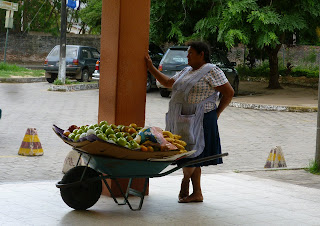In October 2009, not long after we arrived in Lima, we tasted our first churros Peruvian style at the CCM/MTC. We are used to the Mexican style--the long, thin, fried, slightly greasy, sugary kind. The
churro Peruano is shorter, softer, not greasy, and filled with manjar (rich caramel filling made from sweetened condensed milk cooked down until it is golden in color)deep fried and rolled in coarse sugar. We were hooked. I asked the CCM pastry chef if he would teach me how to make churros. Two weeks ago, on a Sunday, he asked me when I wanted to visit the kitchen. We had just returned from Santa Cruz and were going to Bogota the following week. He said he would tell me the following Sunday when he would be making churros. On the following Sunday he said he would be baking churros on Tuesday and could I be there at 8:00a.m. Of course, I could be there. I invited Hermana Whetten, whose husband serves as the CCM president, to go with me. What an adventure we had!

The twenty-six-year-old pastry chef is rolling the finished churro in the coarse sugar from the sugar cane grown in Peru. We were surprised to learn he doesn't use cinnamon
sugar because we thought we tasted cinnamon.

I didn't take pictures during the dough making process. He uses a gigantic Kitchen Aid to mix all the dry ingredients for
ninety churros. The butter, eggs, vanilla are added after the mixer has combined the dry ingredients. I wish I had taken a picture of the roll cutting machine. After the dough is combined and thrown onto the floured, stainless steel table, he weighs the dough to the ounce. Then he oils the roll cutter and places the dough on it. The heavy metal lid is then pressed onto the dough which distributes the dough into 30 rolls. Another heavy handle raises the dough cutter and cuts the rolls. Then each roll is flattened with a metal tube in the shape of a large light bulb. Next, he cuts a corner out of of the bag of manjar and sqeezes manjar crosswise at wide end of the rolled dough. It's tricky. He brings the dough from the top to enclose the manjar and seals it, folding the dough in from the sides, and at the same time rolling up the dough and stretching it into the cigar shape as he rolls. I could hardly wait to get my hands on the dough. I asked him if Hna. Whetten and I could make the last two. We did it. Mine turned out perfectly even though I thought I would never get the hang of stretching the churro as I rolled.

The churros have almost doubled in size. If they rise too much, they will burst in the hot oil.

This shows the golden color of the churros. He could do about a dozen at a time. In the meantime, he was running about preparing the sugar, setting the individual plates, and preparing the serving table. He seemed to return to the churros just at the perfect time. Every batch was golden and perfectly done. I asked him if he had attended the Peru Cordon Bleu. He looked quite surprised that I would ask and said the cost was "caro" or prohibitively expensive. He attended a culinary school in Lima.

This was the first batch of churros to go in. After this batch, he put fewer in. He had to continually adjust the temperature of the oil because the oil heated up too much.

This picture shows about half of the churros which he sugared and placed on individual serving plates.

Ah! Hna. Whetten and I ate our churros warm. You can see the warm, melted manjar which fills the churro from end to end. Every bite is sweet and delicious.

And here we are--two proud pastry chefs showing our prizes which the young chef ceremoniously offered us at the end of the baking lesson.

 The building color is a khaki with "mango" trim.
The building color is a khaki with "mango" trim. This is the view from our bedroom window to the front gate in the upper left corner. The upper right corner is our study window.
This is the view from our bedroom window to the front gate in the upper left corner. The upper right corner is our study window. The building looks so much better with the new colors and the newly painted metal fencing. We hope the owners will paint the inside halls eventually. The manager tells us it's a matter of money.
The building looks so much better with the new colors and the newly painted metal fencing. We hope the owners will paint the inside halls eventually. The manager tells us it's a matter of money.







































